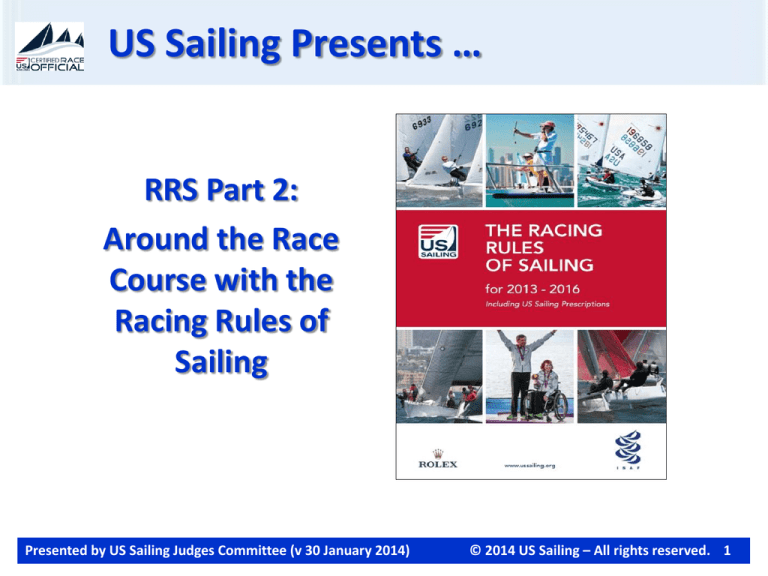
US Sailing Presents …
RRS Part 2:
Around the Race
Course with the
Racing Rules of
Sailing
Presented by US Sailing Judges Committee (v 30 January 2014)
© 2014 US Sailing – All rights reserved. 1
Key Definitions
Keep Clear
A boat keeps clear of another if the
other can sail her course with no
need to take avoiding action …
and,
when … overlapped, if the leeward
boat can change course in both
directions without immediately
making contact …
Presented by US Sailing Judges Committee (v 30 January 2014)
© 2014 US Sailing – All rights reserved. 2
Key Definitions
Room: The space a boat needs in the existing
conditions while maneuvering promptly in a
seamanlike way.
• existing conditions – big waves, strong winds,
current…or really light air
• promptly – time (generally interpreted as
without unreasonable delay)
• seamanlike – not beginner or expert, but
competent, safe
• What kind of boat?
• Includes ability to comply with Part 2 and rule 31
Presented by US Sailing Judges Committee (v 30 January 2014)
© 2014 US Sailing – All rights reserved. 3
Key Definitions
Mark-Room
• Room for a boat to
sail to the mark,
Must give markroom from this point.
Entitled only to enough
space to sail to the mark in
a seamanlike way, not the
space she might want to
make a tactical swing widecut close rounding.
Presented by US Sailing Judges Committee (v 30 January 2014)
© 2014 US Sailing – All rights reserved. 4
Key Definitions
Note: uses room definition
Mark-Room
• … and then room to round the mark as
necessary to sail the course.
Once at the mark,
entitled to space to
round the mark.
Not proper course !
Must give mark-room
from this point.
Presented by US Sailing Judges Committee (v 30 January 2014)
© 2014 US Sailing – All rights reserved. 5
Starting Area
•Is Green an obstruction?
•Who has rights?
•What rules apply?
Presented by US Sailing Judges Committee (v 30 January 2014)
© 2014 US Sailing – All rights reserved. 6
Starting Area
Blue, as leeward right-of-way boat, gets to decide
on which side of Green she wants to sail.
Presented by US Sailing Judges Committee (v 30 January 2014)
© 2014 US Sailing – All rights reserved. 7
Starting Area
Does Yellow have rights to ask for room?
Once the blue boat decides to go to leeward of Green:
• Rule 19 applies
Green is not a mark of the course
• Rule 19.2(b) – Overlapped
Blue (outside) shall give Yellow (inside) room
Presented by US Sailing Judges Committee (v 30 January 2014)
© 2014 US Sailing – All rights reserved. 8
Starting Area
Is Green entitled to room to pass between Blue & Yellow?
• Blue is an obstruction because both Yellow (windward) and
Green (same tack, clear astern)are required to keep clear; but
not a continuing obstruction (definition Obstruction).
• When Green overlaps Yellow and gains right of way she must
give Yellow room to keep clear (rule 15).
• Yellow must keep clear
and give Green room
to pass between her
and Blue if she is able
to when the overlap
begins (rules 11 and 19.2(b)).
Presented by US Sailing Judges Committee (v 30 January 2014)
© 2014 US Sailing – All rights reserved. 9
The Start
Prior to the starting signal, the boats are approaching the line to
start. What is happening? What rules apply? Who has rights?
Presented by US Sailing Judges Committee (v 30 January 2014)
© 2014 US Sailing – All rights reserved. 10
The Start – “Barging”
Before the Starting Signal
Section C Preamble – Section C rules (18, 19, & 20) do not apply at a
starting mark surrounded by navigable water
when approaching to start.
Rule 11 – On the Same Tack, Overlapped
• Windward boat shall keep clear of a leeward boat
Rule 16 – Changing Course
• 16.1 Shall give room to
keep clear
The Blue boat must shut the
door before Yellow gets her bow
stuck in to leeward of the
committee boat.
Presented by US Sailing Judges Committee (v 30 January 2014)
© 2014 US Sailing – All rights reserved. 11
The Start – “Barging”
“Barging” can also apply at the pinend of the starting line.
Presented by US Sailing Judges Committee (v 30 January 2014)
© 2014 US Sailing – All rights reserved. 12
Rule 17 at Starting Line
What about after the starting
signal?
• How was overlap established?
• Is there a Rule 17 proper course
limitation on the leeward boat?
Before the starting signal Blue has
no proper course, but after the
starting signal she does.
Presented by US Sailing Judges Committee (v 30 January 2014)
© 2014 US Sailing – All rights reserved. 13
The Start
The rules that apply change as the situation changes.
Rule 17 – On the Same Tack; Proper Course
Blue (leeward) did not establish the overlap from clear
astern. Blue is not bound by Rule 17 and may sail above
her proper course.
Rule16 – Changing Course
Blue (RoW)
shall give room
to keep clear
Rule 11 – On the Same Tack, Overlapped
Yellow (windward) shall keeps clear
Presented by US Sailing Judges Committee (v 30 January 2014)
Rule 12 – On the Same Tack, Not
Overlapped
Yellow (clear astern) shall
keeps clear
© 2014 US Sailing – All rights reserved. 14
The Start
The rules that apply change as the situation changes.
Rule 17 – On the Same Tack; Proper Course
Blue (leeward) shall not sail above her proper course.
Before the starting signal she has no proper course, but
after the starting signal she does.
Rule16 – Changing Course
Blue (RoW)
shall give room
to keep clear
Rule 11 – On the Same Tack, Overlapped
Yellow (windward) shall keeps clear
Rule 15 – Acquiring Right of Way
Blue (RoW) shall initially give room
Presented by US Sailing Judges Committee (v 30 January 2014)
Rule 12 – On the Same Tack, Not
Overlapped
Blue (clear astern) shall
keeps clear
© 2014 US Sailing – All rights reserved. 15
The Start
What is L’s Proper Course?
• After the starting signal, Blue (leeward) may not sail above her proper
course, which, when sailing to windward, is usually close-hauled (rule17).
• However, in order to pass on the
correct side of the starting mark,
Blue’s proper course may be to
momentarily luff up to head to
wind (definition Proper Course).
• Yellow must keep clear of Blue (rule 11), but while
Blue is changing course she must give Yellow room
to do so (rule 16).
Presented by US Sailing Judges Committee (v 30 January 2014)
© 2014 US Sailing – All rights reserved. 16
Windward Legs
RRS 10 port must keep clear
RRS 16.1 protects the keep-clear
boat from unpredictable or lastsecond changes of course by the
right-of-way boat, which would
prevent her from keeping clear.
Possible conclusions:
Port kept clear
Port did not keep clear
Stbd did not give room while
altering….
Presented by US Sailing Judges Committee (v 30 January 2014)
© 2014 US Sailing – All rights reserved. 17
Windward Legs
So how close is too close?
• On a two lane road when wanting to pass, it
depends…
• Are you driving a race car or a tractor?
• What are you passing?
• What’s coming in the opposite direction?
Presented by US Sailing Judges Committee (v 30 January 2014)
© 2014 US Sailing – All rights reserved. 18
Windward Legs
So how close is too close?
• In sailboat racing it also
depends on…
• Distance between boats
• Speed of boats
• Size, manuverability, of
boats
• Visibility between boats
• Angle of convergence
•
key facts needed to
reach a conclusion
Presented by US Sailing Judges Committee (v 30 January 2014)
© 2014 US Sailing – All rights reserved. 19
Windward Mark
• Not overlapped at the zone (3 hull lengths)
• Yellow must give Blue mark-room, which includes room
to gybe at the mark if that is Blue’s proper course.
• Rule 18 applies until
Blue no longer needs
mark-room from
Yellow.
Presented by US Sailing Judges Committee (v 30 January 2014)
© 2014 US Sailing – All rights reserved. 20
Windward Mark
Rule 18.3 – Tacking When Approaching a Mark
• Blue and Orange (port) change tack in the zone.
• Yellow and Green (starboard) are fetching their mark.
Presented by US Sailing Judges Committee (v 30 January 2014)
© 2014 US Sailing – All rights reserved. 21
Windward Mark
Rule 18.3 – Tacking When Approaching a Mark
In position 4, Orange luffs above close-hauled
to clear the mark. As a result of her
luff, Green sails above close-hauled
to avoid Orange. Orange breaks
rule 18.3(a).
Rule 11 – Same Tack, Overlapped
Orange is leeward/inside boat.
Rule 13 - While Tacking
Orange passes head to wind and becomes subject to
rule 13 until she reaches a close-hauled course.
Rule 10 – Opposite Tacks
Presented by US Sailing Judges Committee (v 30 January 2014)
© 2014 US Sailing – All rights reserved. 22
Windward Mark
Rule 18.3 – Tacking When Approaching a Mark
• One boat (port) changes tack in the zone
• When the other (starboard) is fetching the mark
Rule 18.2 does not apply and
instead 18.3(a) does:
• Blue passes head to wind
inside the zone.
• Yellow is fetching the mark.
• Blue shall not prevent
Yellow from passing the
mark on the required side.
Presented by US Sailing Judges Committee (v 30 January 2014)
© 2014 US Sailing – All rights reserved. 23
Windward Mark
Rule 18.3 – Tacking When Approaching a Mark
• One boat (port) changes tack in the zone
• When the other (starboard) is fetching the mark
Rule 18.2 does not apply and instead
18.3(b) does:
• Blue changes her tack inside
the zone.
• Yellow is fetching the mark.
• Blue shall give the Yellow markroom to pass the mark inside
her.
Presented by US Sailing Judges Committee (v 30 January 2014)
© 2014 US Sailing – All rights reserved. 24
Windward Mark
Rule 31 – Touching a Mark
• Rule 31 – While racing, a boat shall not touch a mark that begins,
bounds, or ends the leg of the course on which she is sailing…
• Rule 44.1 – Blue must take a
penalty by promptly sailing
well clear and making one turn
including one tack and one
gybe.
• Rule 44.2 – Blue must keep
clear of other boats while doing
her penalty turn.
Presented by US Sailing Judges Committee (v 30 January 2014)
© 2014 US Sailing – All rights reserved. 25
Offwind Leg
Position 1: Blue is clear ahead of Yellow
Position 2: If Yellow obtains an inside overlap between
Blue and the shore, is she entitled to
room to pass between them?
Presented by US Sailing Judges Committee (v 30 January 2014)
© 2014 US Sailing – All rights reserved. 26
Offwind Leg
• At the moment Yellow obtains the overlap, if there
is enough room for Yellow to sail between Blue and
the shore without any risk of touching either, Blue
must give Yellow room to pass between her and
shore.
• Blue’s obligation continues as long as Yellow has an
inside overlap and they are passing the continuing
obstruction.
• If Yellow needs more
room to miss a point
of land, Blue must
bear off to provide
that room.
Presented by US Sailing Judges Committee (v 30 January 2014)
© 2014 US Sailing – All rights reserved. 27
Downwind Leg
Rule 17 – On the Same Tack; Proper Course
How was the overlap established?
• Did the leeward boat become overlapped from clear astern
within two of her hull lengths of the windward boat?
What is proper course?
• A course a boat would sail to finish as soon as possible in the
absence of the other boats referred to in the rule using the
term. A boat has no proper course before her starting signal.
• Different boats may have different proper courses at the same
time.
Presented by US Sailing Judges Committee (v 30 January 2014)
© 2014 US Sailing – All rights reserved. 28
Downwind Leg
• Blue became overlapped from clear astern and then
luffed above her proper course. The intent was to
make it difficult for
Yellow to stay ahead.
• In the absence of
Yellow, Blue would
not luff.
• Blue broke rule 17.
Presented by US Sailing Judges Committee (v 30 January 2014)
© 2014 US Sailing – All rights reserved. 29
Downwind Leg
• Blue became overlapped from
clear astern and then sailed high
to go above the slower gray
boats in front of her.
• In the absence of Yellow, Blue
would still sail high of the gray
boats.
• Because she would do this even
in the absence of Yellow, it is a
legitimate proper course.
Presented by US Sailing Judges Committee (v 30 January 2014)
© 2014 US Sailing – All rights reserved. 30
Downwind Leg
• Yellow established the overlap while more than
two boat lengths away from the blue boat.
• The yellow boat is not limited and may sail up to
head to wind.
Presented by US Sailing Judges Committee (v 30 January 2014)
© 2014 US Sailing – All rights reserved. 31
Downwind Leg
Position 1: Yellow established the overlap as in the previous slide (not 17)
Position 2: The blue boat luffs hard breaking the overlap.
Position 3: The blue boat bears away causing the overlap to begin again. The
yellow boat does not have to give the blue boat room to keep clear
under rule 15
since she gained
leeward right-of-way
as a result of the blue
boats actions.
Position 4: The yellow boat must
promptly bear away to
her proper course
because she became
overlapped from clear
astern.
Presented by US Sailing Judges Committee (v 30 January 2014)
© 2014 US Sailing – All rights reserved. 32
Downwind Leg
Position 1: No overlap
Position 2: Yellow becomes overlapped from clear
astern within two boat lengths of Blue.
Position 3: Yellow gybes to port. They are still
overlapped because they are >90º off
wind, however, rule 17 requires they
remain on the same tack.
Position 4: Yellow gybes back.
Position 5: Yellow may luff. She is not limited by 17.
However, rule 15 requires yellow to
initially give the blue boat room to keep
clear. Then as she changes course
yellow, under rule 16.1, must give blue
additional room to keep clear.
Presented by US Sailing Judges Committee (v 30 January 2014)
© 2014 US Sailing – All rights reserved. 33
Downwind Leg
In position 3, Blue bears away creating
an overlap. Because Blue & Yellow are
sailing > 90º off the wind, they are
overlapped on opposite tacks.
In position 4, Blue gybes. As soon as her
boom crosses centerline Blue & Yellow
are immediately overlapped on the
same tack.
Blue can luff to head to wind, but must
give Yellow room to keep clear, under
both rule 15 and rule 16.1.
Presented by US Sailing Judges Committee (v 30 January 2014)
© 2014 US Sailing – All rights reserved. 34
Leeward Mark
Yellow (starboard) is on
the opposite tack and
well behind Blue (port),
but Yellow has an inside
overlap when Blue
enters the zone.
Presented by US Sailing Judges Committee (v 30 January 2014)
© 2014 US Sailing – All rights reserved. 35
Leeward Mark
Giving Room and Keeping Clear
• Green is the inside/windward
boat.
• She does not have right of
way. Rule 11 does not turn off.
• Blue and Yellow must give her
space to sail to the mark in a
seamanlike way, and then
space to round the mark as
necessary to sail the course.
Presented by US Sailing Judges Committee (v 30 January 2014)
© 2014 US Sailing – All rights reserved. 36
Leeward Mark
Giving Room and Keeping Clear
• Green is the
inside/leeward boat.
• She is the right-of-way
boat (rule 11).
• Blue and Yellow must
keep clear of Green and
give her mark-room.
Presented by US Sailing Judges Committee (v 30 January 2014)
© 2014 US Sailing – All rights reserved. 37
Leeward Mark
Position 1: Yellow (starboard) is
the right-of-way
boat.
Position 2: When Blue enters the
zone, she is clear
ahead of Yellow.
Rule 18.2 (b) now
requires Yellow to
give Blue mark-room.
Presented by US Sailing Judges Committee (v 30 January 2014)
© 2014 US Sailing – All rights reserved. 38
Leeward Mark
Rule 18.4 requires an inside overlapped right-of-way boat
to sail no further from the mark than needed to sail her
proper course.
• Yellow must gybe at the mark
• Yellow may not luff away from the mark
prior to gybing if that takes her farther
from the mark than her proper course.
• If this is a wing mark then gybing right at
the mark might be Yellow’s proper course.
• If this is a leeward mark then making a
tactical rounding (swing wide-cut close)
might be Yellow’s proper course.
Presented by US Sailing Judges Committee (v 30 January 2014)
© 2014 US Sailing – All rights reserved. 39
Leeward Mark
• Green, Yellow and Blue
make it obvious that
Red is outside the zone.
• Gray is overlapped with
Red.
• Red must give Gray
room to round the
mark.
Presented by US Sailing Judges Committee (v 30 January 2014)
© 2014 US Sailing – All rights reserved. 40
The Finish
• The preamble to Section C turns Rule 18 off at a starting mark, but it does
not turn it off at a finishing mark.
• Rule 18.1(a) turns rule 18 off at a windward mark (including a windward
finishing mark) when the two boats are coming into the mark on opposite
tacks.
• Rule 18.2(b)
requires Yellow
(outside) to give
Blue (inside) markroom.
Presented by US Sailing Judges Committee (v 30 January 2014)
© 2014 US Sailing – All rights reserved. 41
The Finish
• A boat finishes when any part of her hull, or crew or equipment in
normal position crosses the finishing line in the direction of the course
from the last mark…
• After finishing you must clear the finishing line and marks. You are
still racing until you do so.
• You have finished when
you break the plane of the
finishing line. Position 2
for both boats.
• You are still racing until you
have “cleared the finishing line
and marks”. You may clear the line in either direction (rule 28.1).
• What is cleared”? No longer on line at all and well clear of the marks
(Appeal 26). For Blue position 3 and for Yellow at position 4.
Presented by US Sailing Judges Committee (v 30 January 2014)
© 2014 US Sailing – All rights reserved. 42
The Finish
• If you touch a finishing mark before clearing the finishing line, you
must complete a one-turn penalty and then sail completely to the
course side of the line before finishing.
• In this example, Blue completed her gybe (position 4) and
completed her tack (position 9) then re-crossed the finishing line to
finish.
• You can complete your
one-turn penalty
anywhere, but after
completing one tack and
one gybe you must sail
completely to the course
side of the line and then
finish.
Presented by US Sailing Judges Committee (v 30 January 2014)
© 2014 US Sailing – All rights reserved. 43
The Finish
Rule 23.1 – If reasonably possible, a boat not racing shall not
interfere with a boat that is racing.
• Interference is adversely affecting a boat’s forward motion
or maneuverability.
• This applies to both
before or after racing.
• Be careful where you
sail; watch your wind
shadow and physical
presence.
Presented by US Sailing Judges Committee (v 30 January 2014)
© 2014 US Sailing – All rights reserved. 44
Penalties
Rule 44 Penalties At The Time Of An Incident
• When you break a Part 2 rule,
you may exonerate yourself by
sailing well clear of other boats
as soon as possible and making
two turns, including two tacks
and two gybes.
• But, if you gained a significant
advantage, caused injury or
serious damage, must retire!
Presented by US Sailing Judges Committee (v 30 January 2014)
© 2014 US Sailing – All rights reserved. 45




